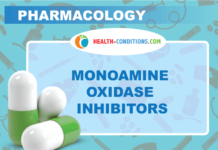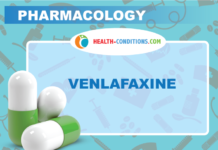Propranolol is the prototype of beta blocking drugs. Propranolol is the standard drug against which newer developed beta blockers compared for systemic use. Propranolol is non-selective beta blocker i.e. it can block both β1 and β2 receptors.
GENERIC NAME: Propranolol
BRAND NAME Inderal, Bedranol SR, Dositon, Sumial.
MECHANISM OF ACTION
Propranolol is non-selective beta blocker i.e. it can block both β1 and β2 receptors and possess intrinsic sympathomimetic activity (ISA). Propranolol blocks the beta receptor resulting in inhibition of sympathetic nervous system thus, decreased heart rate, delayed conduction through AV node, and reduced contractility which finally decreased the cardiac output and oxygen demand by heart muscles. Since it has weak ISA therefore it also weakly stimulate β1 and β2 receptors and leads to diminish effects on cardiac output and rate. This phenomenon is beneficial in patients who can’t tolerate other beta blockers because of pre-existing bradycardia or heart block.
PHARMACOKINETICS
Propranolol is well absorbed after oral administration. Propranolol undergoes hepatic metabolism; its bioavailability is relatively low i.e. 30%. Sustained release preparation of propranolol is available. . It is rapidly distributed in the body. Propranolol has high lipid solubility and rapidly cross the blood brain barrier. Elimination half-life is 3.5-6 hours. It is excreted little unchanged in the urine
INDICATIONS
- Hypertension
- Ischemic heart disease
- Cardiac arrhythmias
- Heart failure
- Following Myocardial infarction
- Dissecting aneurysm (Esmolol)
- Glaucoma
- Migraine prophylaxis
- Hyperthyroidism
- Essential tremors
CONTRAINDICATIONS
- Hypersensitivity
- Renal failure (Atenolol)
- Decompensated heart failure
- Peripheral vascular disease
- Raynaud’s phenomenon
- Asthma
- COPD
- Bronchoconstriction
- Bradyarrythmia
SIDE EFFECTS & ADVERSE EFFECTS
- Insomnia
- Constipation
- Intolerance include fatigue, cold extremities, erectile dysfunction
- Asthma or COPD (with non-selective beta blockers)
- Hypoglycemia (insulin dependent diabetic patient)
- Heart block
- Metabolic disturbance
- Sedation
- Sleep disturbance
- Others include
- Rash
- Fever
- Blurred vision
- Weakness
- Muscle cramps
- Headache
- Nausea vomiting
- Confusion
DRUG INTERACTION
- Antacids and antidiarrhoeals may cause modest reduction in the absorption of propranolol but this effects is clinically not significant.
- Most NSAIDs can increase blood pressure when given with propranolol including piroxicam, Indometacin, ibuprofen, naproxen.
- Barbiturates effected the plasma level and action of propranolol that is metabolized by liver.
- The use of concurrent use of propranolol and dihydropyridine type calcium channel blockers appeared to be safe and useful clinically e.g. felodipine, isradipine, lacidipine, nicardipine, nimodipine. Although Nifedipine and nifoldipine may cause severe hypotension and heart failure when given with propranolol
- Diltiazem may enhance the antihypertensive effects of propranolol and clinically significant when given concurrently but close monitoring is necessary.
- Verapamil may enhance the antihypertensive effects of propranolol and clinically significant when given concurrently but close monitoring is necessary.
- Bupropion may cause bradycardia and severe hypotension when given with propranolol.
- The concurrent use of ergot derivatives and propranolol in the management of migraine may cause severe peripheral vasoconstriction and hypertension.
- Fish oil may enhance the hypotensive effects of propranolol.
- The concurrent use of flecainide and propranolol may cause additive cardiac depressant effects.
- Food may increase, decrease or no change to the propranolol but it has no clinically significance.
- Tobacco smoking may reduce the beneficial effects of propranolol i.e. heart rate and blood pressure.
- Rifampicin may increase the clearance of propranolol when given concurrently
- Propafenone may increase the plasma level (two to five fold) of propranolol which can increase toxicity.
- Concurrent use of chlorpromazine with propranolol may increase the plasma level of all drugs. Both drugs can cause hypotension.
- Propranolol may cause anaphylactic reactions of penicillin when given concurrently.
NURSING INTERVENTIONS
- Inquire patient’s complete health history including allergies, diabetes or any respiratory diseases
- Monitor blood pressure and pulse prior administration of medicine. If blood pressure and pulse is not in normal range inform the health practitioner.
- Observe daily intake an output of fluid. Check body weight.
- If patient is on parenteral drug then check blood pressure and pulse frequently.
- Patient with respiratory disease specially with asthma or COPD should be closely monitored for sign and symptoms.
- Observe lab determining electrolytes, BUN, creatinine levels.
- In diabetic patient observe hypoglycemic effects
PATIENT EDUCATION
- Counsel the right dose and time of medicine.
- Don’t break, crush or dissolve sustained release medicine.
- Counsel them the possible side effects of medicine.
- If blood pressure or pulse is too low then immediate contact to the doctors
- Change position slowly to avoid orthostatic hypotension
- Ask doctor prior to take any multivitamins or any supplements
- Report immediately to the doctor if feeling chest pain, SOB, faintness with exercise or during work activities.













